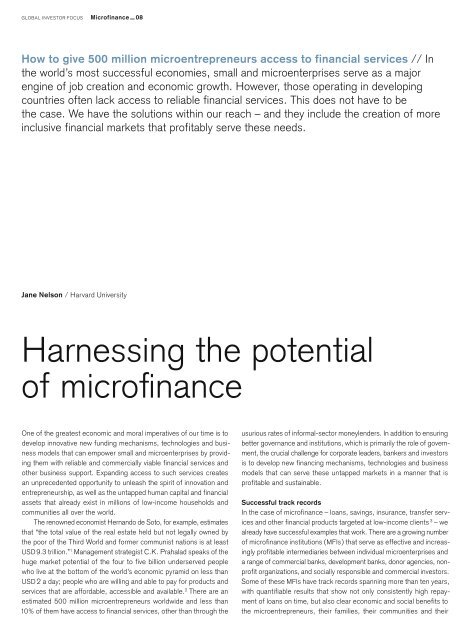Microfinance
Global Investor Focus, 02/20065 Credit Suisse
Global Investor Focus, 02/20065
Credit Suisse
You also want an ePaper? Increase the reach of your titles
YUMPU automatically turns print PDFs into web optimized ePapers that Google loves.
GLOBAL INVESTOR FOCUS<br />
<strong>Microfinance</strong>—08<br />
How to give 500 million microentrepreneurs access to financial services // In<br />
the world’s most successful economies, small and microenterprises serve as a major<br />
engine of job creation and economic growth. However, those operating in developing<br />
countries often lack access to reliable financial services. This does not have to be<br />
the case. We have the solutions within our reach – and they include the creation of more<br />
inclusive financial markets that profitably serve these needs.<br />
Jane Nelson / Harvard University<br />
Harnessing the potential<br />
of microfinance<br />
One of the greatest economic and moral imperatives of our time is to<br />
develop innovative new funding mechanisms, technologies and business<br />
models that can empower small and microenterprises by providing<br />
them with reliable and commercially viable financial services and<br />
other business support. Expanding access to such services creates<br />
an unprecedented opportunity to unleash the spirit of innovation and<br />
entrepreneurship, as well as the untapped human capital and financial<br />
assets that already exist in millions of low-income households and<br />
communities all over the world.<br />
The renowned economist Hernando de Soto, for example, estimates<br />
that “the total value of the real estate held but not legally owned by<br />
the poor of the Third World and former communist nations is at least<br />
USD 9.3 trillion.” 1 Management strategist C.K. Prahalad speaks of the<br />
huge market potential of the four to five billion underserved people<br />
who live at the bottom of the world’s economic pyramid on less than<br />
USD 2 a day; people who are willing and able to pay for products and<br />
services that are affordable, accessible and available. 2 There are an<br />
estimated 500 million microentrepreneurs worldwide and less than<br />
10% of them have access to financial services, other than through the<br />
usurious rates of informal-sector moneylenders. In addition to ensuring<br />
better governance and institutions, which is primarily the role of government,<br />
the crucial challenge for corporate leaders, bankers and investors<br />
is to develop new financing mechanisms, technologies and business<br />
models that can serve these untapped markets in a manner that is<br />
profitable and sustainable.<br />
Successful track records<br />
In the case of microfinance – loans, savings, insurance, transfer services<br />
and other financial products targeted at low-income clients 3 – we<br />
already have successful examples that work. There are a growing number<br />
of microfinance institutions (MFIs) that serve as effective and increasingly<br />
profitable intermediaries between individual microenterprises and<br />
a range of commercial banks, development banks, donor agencies, nonprofit<br />
organizations, and socially responsible and commercial investors.<br />
Some of these MFIs have track records spanning more than ten years,<br />
with quantifiable results that show not only consistently high repayment<br />
of loans on time, but also clear economic and social benefits to<br />
the microentrepreneurs, their families, their communities and their

















